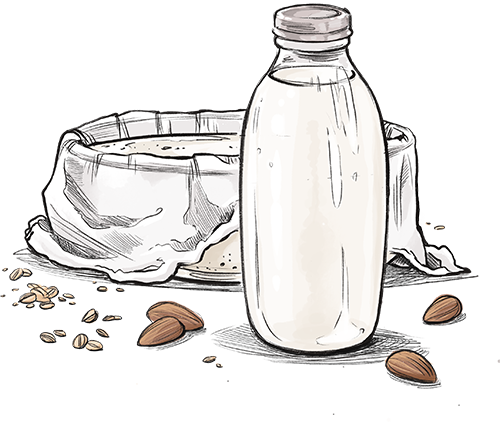At Home — August 24, 2020
Recipes and Tips for a Sustainable Kitchen
Ideas, tips and recipes for making more with what you have on hand.
By Jill Haapaniemi
Recipe Illustrations by Lori Bailey
This guide was published in The At Home Issue of Life & Thyme Post, our limited edition printed newspaper for Life & Thyme members.
Buy local. Buy in season. Buy in bulk. Bring your own bags. Reduce your waste. These are things we know we should do, and for many of us, the Covid-19 pandemic has required that we change our budgets and lifestyle. By maintaining more economic and less wasteful practices, this time has also been an opportunity to consider how we can continue to be more sustainable in the long run.
The following are a few tips to help us keep those practices in place, as well as a few recipes designed to make the most of what we’re able to get our hands on at the moment.
Reduce shopping trips: Dialing back our stops at the store incentivizes bulk purchasing and reduces spending, travel and packaging intake.
Opt for local: Right now, you might be purchasing directly from farmers or small markets to support local businesses and avoid crowded supermarkets. But in continuing to do so, this practice also reduces food miles and assures the purchase of more affordable, seasonal items.
Plan ahead: In attempting to stretch one shopping trip, it makes a big difference to prep ingredients in advance. Roast a heap of vegetables for salads and sandwiches. Freeze fresh bread so it lasts all week for morning toast. Keep a tub or jar beside you as you cook and toss in stalks, skins, bones and peels for a pot of delicious stock.
Purchase items that keep: Packaged foods aren’t the only items that have longer shelf lives. Having ingredients that can be kept for longer periods of time—like legumes, grains, seeds, nuts, eggs and root vegetables—isn’t just economical, it also means you’re likely buying real food, which is good for your health and budget.
Embrace imperfection: Food is not naturally unblemished and perfectly shaped like we see in supermarkets. Bumps, bruises and odd shapes are perfectly edible and should never be thrown away. If your fruits or vegetables start to brown or wilt, you can likely still use them; try blending them into smoothies or soups.
Never forget the shopping bags: Tote bags can be kept in a purse, backpack or car. They are light and easy to carry, and essential for all of those times you pop into a shop.*
*During the pandemic, many stores are not allowing the use of some reusable resources like shopping bags, so in the meantime, returning groceries directly back to your cart after check-out will keep the use of paper and plastic to a minimum.

Ingredients
- 1 cup almonds
- 1 cup rolled oats
- 5 cups water, plus more for soaking overnight
Missing ingredients? We got you.
Find and support independent producers, farmers and purveyors in your local area with our crowdsourced directory, Supply Home Cooks.
Homemade Almond-Oat Milk
This recipe is two for the price of one. The first is a quick and easy dairy-free milk made with almonds and oats—although you could use one or the other, and even substitute with another nut of your choice.
- Soak almonds in plenty of water overnight. Rinse and drain.
- Blend almonds and oats with 5 cups of fresh water until finely ground. Pour over a large muslin-lined bowl.
- Suspend almonds until almond milk strains away from solids, squeezing muslin sack to remove all liquid.
- Dry out ground almonds and oats and use for seed, nut and oat granola.
- Store almond milk in an airtight container and refrigerate up to 5 days.

Ingredients
- Leftover ground almonds and oats from homemade milk (about 3 cups)
- ½ cup pumpkin seeds
- 1 tbsp. chia seeds
- ⅓ cup olive oil
- ¼ cup honey
- 1 tsp. cinnamon
- ¼ tsp. nutmeg
- ¼ tsp. cardamom
- Pinch of salt
Missing ingredients? We got you.
Find and support independent producers, farmers and purveyors in your local area with our crowdsourced directory, Supply Home Cooks.
Seed, Nut and Oat Granola
This granola utilizes the leftover ground nuts and oats from the Almond-Oat Milk, and is a great way to get the most out of these ingredients with zero waste. Both recipes also cut out the preservatives and added sugars that are often found in these foods, not to mention the store-bought packaging.
- Preheat oven to 375ºF.
- In a large bowl, mix all ingredients together until well combined.
- Spread over a rimmed baking sheet in an even layer. Roast until granola is toasty, slightly darkened, and begins to smell fragrant, for about 30 to 35 minutes, and stirring halfway through.
- Store in an airtight container.

Ingredients
- 2 cups flour
- 2 cups plain, full-fat yogurt
- 2-4 tbsp. discarded sourdough starter
Missing ingredients? We got you.
Find and support independent producers, farmers and purveyors in your local area with our crowdsourced directory, Supply Home Cooks.
Sourdough Starter Flatbreads
If you’re part of the sourdough movement, don’t let that starter go to waste. There are lots of recipes out there for baking with the discarded starter, from muffins and pancakes to crumpets and banana bread. One of my favorites is these quick flatbreads. I use them for tacos, wraps and naan. I also love to cook them in lots of butter and dip them into crème fraîche with a squeeze of lemon.
- In a mixing bowl, combine all ingredients until combined. Knead for a few minutes until the dough becomes slightly elastic.
- Cut dough into 6 even pieces and roll each ⅛-inch thick.
- In a lightly oiled skillet over medium-high heat, cook flatbreads until they start to puff up and char, for 2 to 3 minutes per side.

Ingredients
- 2-3 cups broccoli stems, fennel tops, or cabbage cores cut into 1-inch pieces
- 3-4 tbsp. olive oil
- 1 tsp. salt
- ½ tsp. cracked pepper
Missing ingredients? We got you.
Find and support independent producers, farmers and purveyors in your local area with our crowdsourced directory, Supply Home Cooks.
Roasted Stems and Stalks
Broccoli, brussels sprouts, cauliflower, cabbage, fennel and asparagus are just some of the vegetables that get de-stalked, stemmed and cored when we cook with them. Although tough, these parts are still perfectly edible and shouldn’t go to waste. As you cook with these ingredients throughout the week, save the offcuts in a jar or container, and then roast them all together. The key is to give them enough heat and time to cook through the tough fibers.
My favorite way to use these odd offcuts is in a grain bowl. Pile the roasted vegetables alongside farro, brown rice, quinoa, teff or any other grain. Top with a protein like soft-boiled egg, tofu or chicken. And then sprinkle with nuts or seeds, and drizzle with a dressing of your choice.
- Preheat oven to 400ºF.
- On a baking sheet, toss all ingredients together until vegetables are evenly coated in oil; arrange in an even layer. Roast until vegetables start to brown, for about 20 minutes.
- Reduce oven temperature to 325ºF and continue cooking for another 30 to 40 minutes, stirring occasionally until vegetables are tender and a fork goes in easily.
- Serve vegetables with your favorite grain, protein, nuts and dressing for a dinner bowl, or toss them into a salad or pasta.


Our comments section is for members only.
Join today to gain exclusive access.